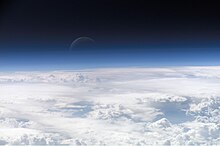Air
This is a learning resource about Air refering to the atmosphere of earth. First of all we think about oxygen as the most important gas, due to the fact that we need oxygen for breathing. But the atmosphere of earth is contains many others gases, dust and sometimes toxic substances. Furthermore the fraction of greenhouse gas in our atmosphere has an impact on the climate. The learning resources introduces to the topic air in multiple aspect.


Definition: Atmosphere of Earth
editThe atmosphere of Earth is the layer of gases, commonly known as air, that surrounds the planet Earth and is retained by Earth's gravity. The atmosphere of Earth protects life on Earth by creating pressure allowing for liquid water to exist on the Earth's surface, absorbing ultraviolet solar radiation, warming the surface through heat retention (greenhouse effect), and reducing temperature extremes between day and night (the diurnal temperature variation).
Subtopics
editAtmosphere as Mix of Gases
editBy volume, dry air contains 78.09% nitrogen, 20.95% oxygen,[2] 0.93% argon, 0.04% carbon dioxide, and small amounts of other gases. Air also contains a variable amount of water vapor, on average around 1% at sea level, and 0.4% over the entire atmosphere. Air content and atmospheric pressure vary at different layers, and air suitable for use in photosynthesis by terrestrial plants and breathing of terrestrial animals is found only in Earth's troposphere and in artificial atmospheres.
The atmosphere has a mass of about 5.15×1018 kg,[3] three quarters of which is within about 11 km (6.8 mi; 36,000 ft) of the surface. The atmosphere becomes thinner and thinner with increasing altitude, with no definite boundary between the atmosphere and outer space. The Kármán line, at 100 km (62 mi), or 1.57% of Earth's radius, is often used as the border between the atmosphere and outer space. Atmospheric effects become noticeable during atmospheric reentry of spacecraft at an altitude of around 120 km (75 mi). Several layers can be distinguished in the atmosphere, based on characteristics such as temperature and composition.
The study of Earth's atmosphere and its processes is called atmospheric science (aerology). Early pioneers in the field include Léon Teisserenc de Bort and Richard Assmann.[4]
Seiten-Information
editDiese Seite wurde auf Basis der folgenden Wikiversity-Quelle erstellt:
References
edit- ↑ "Gateway to Astonaut Photos of Earth". NASA. Retrieved 2018-01-29.
- ↑ Zimmer, Carl (3 October 2013). "Earth's Oxygen: A Mystery Easy to Take for Granted". The New York Times. Retrieved 3 October 2013.
{{cite news}}: Check|authorlink=value (help) - ↑ Lide, David R. Handbook of Chemistry and Physics. Boca Raton, FL: CRC, 1996: 14–17
- ↑ M. Vázquez; A. Hanslmeier (2006). Ultraviolet Radiation in the Solar System. 331. Springer Science & Business Media. 17. doi:10.1007/978-1-4020-3730-6. ISBN 978-1-4020-3730-6. Bibcode: 2005ASSL..331.....V. https://books.google.com/books?id=OlckxY7BA_0C&pg=PA17.